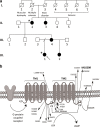ADCY5-related dyskinesia presenting as familial myoclonus-dystonia
- PMID: 28229249
- PMCID: PMC5359383
- DOI: 10.1007/s10048-017-0510-z
ADCY5-related dyskinesia presenting as familial myoclonus-dystonia
Abstract
We describe a family with an autosomal dominant familial dyskinesia resembling myoclonus-dystonia associated with a novel missense mutation in ADCY5, found through whole-exome sequencing. A tiered analytical approach was used to analyse whole-exome sequencing data from an affected grandmother-granddaughter pair. Whole-exome sequencing identified 18,000 shared variants, of which 46 were non-synonymous changes not present in a local cohort of control exomes (n = 422). Further filtering based on predicted splicing effect, minor allele frequency in the 1000 Genomes Project and on phylogenetic conservation yielded 13 candidate variants, of which the heterozygous missense mutation c.3086T>G, p. M1029R in ADCY5 most closely matched the observed phenotype. This report illustrates the utility of whole-exome sequencing in cases of undiagnosed movement disorders with clear autosomal dominant inheritance. Moreover, ADCY5 mutations should be considered in cases with apparent myoclonus-dystonia, particularly where SCGE mutations have been excluded. ADCY5-related dyskinesia may manifest variable expressivity within a single family, and affected individuals may be initially diagnosed with differing neurological phenotypes.
Keywords: ADCY5; Exome sequencing; Familial dyskinesia; Myoclonus-dystonia.
Conflict of interest statement
Conflict of interest
The authors declare that they have no conflict of interest.
Ethical approval
All procedures performed in studies involving human participants were in accordance with the ethical standards of the institutional and/or national research committee and with the 1964 Helsinki declaration and its later amendments or comparable ethical standards.
Informed consent
Informed consent was obtained from all individual participants included in the study.
Figures

References
Publication types
MeSH terms
Substances
Supplementary concepts
LinkOut - more resources
Full Text Sources
Other Literature Sources

